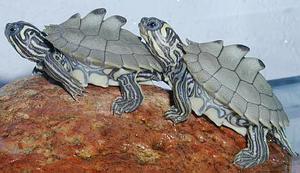Turtles and Tortoises: Testudines
Physical Characteristics

Turtles and tortoises, which are in the order Testudines, have bony upper and lower shells that surround much of the body. The upper shell, or carapace (KARE-a-pays), can be tall and rounded, can be flat, or can be some shape in between. The lower shell, or plastron (PLAS-trun), can cover most or just a portion of the bottom of the animal, depending on the species. In most cases, the upper shell connects to the lower shell by way of a bony bridge. In some species, the bridge is made of more flexible tissue called ligament (LIH-guh-ment). The hard shell often is covered with large scales called scutes (SCOOTS). In some species, new scutes grow under the old ones, and the old ones pile up. A person can count the number of scutes in the pile to tell how old the turtle is. Softshell turtles have no scutes. They do have small bony shells, but the bones are covered with leathery or rubbery skin.
Besides shells, another feature of turtles and tortoises is that they have no teeth. Instead they have hard, flat surfaces on their jaws that allow them to grip and tear off bits of plants or animals for feeding. Sometimes these surfaces come to a sharp point in front and look much like the hook on the end of a hawk's or eagle's beak. Turtles with such pointed upper jaws are often said to have horny beaks.
Turtles and tortoises, like birds, dogs, humans, and other animals, are vertebrates (VER-teh-brehts), which means they have a backbone. Turtles and tortoises are unlike all other vertebrates in that their hip and shoulder bones are inside the rib cage instead of outside because the ribs are attached to the upper and lower shells. If the shoulder and hip bones were outside the rib cage, they would have to be outside the shell.
Many turtles and tortoises have long necks, which they can pull back or stretch out. Because some species can pull their necks straight back and others can only pull them sideways, scientists often describe them as being in the hidden-necked group, called Cryptodira, or in the side-necked group, called Pleurodira. A hidden-necked turtle can pull its neck straight back and usually tuck its whole neck and head inside the shell. A side-necked turtle pulls its neck back sideways, often tucking the neck and head along the side of the body and against the bridge between the upper and lower shells.
Turtles come in many sizes. The largest living species is the leatherback sea turtle, which can weigh up to 1,191 pounds (540 kilograms), or more than half a ton. The upper shell can become 8 feet (2.4 meters) long. Some of the smallest of the Testudines are the speckled cape tortoise, flattened musk turtle, and bog turtle. The carapace on each of these three animals barely reaches 4.7 inches (12 centimeters) long.
Additional topics
Animal Life ResourceDinosaurs, Snakes, and Other ReptilesTurtles and Tortoises: Testudines - Physical Characteristics, Behavior And Reproduction - GEOGRAPHIC RANGE, HABITAT, DIET, TORTOISES TURTLES AND PEOPLE, CONSERVATION STATUS